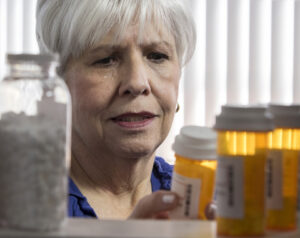
With the end of summer approaching, it is time to return to regular routines. During this transition period many parents are busy organizing childcare for their children, and grandparents, other family members, or friends often step in to offer their support.If you do not regularly have children visit your home, you may not have recently thought about all the ways to “childproof” your space. Locking up cabinets with cleaning products and putting away breakable heirlooms are the first things thought of, but don’t forget about your medications. Medication-related accidents can cause serious harm. It is important for everyone to regularly review medication safety, especially if having kids in your home.Store medications in a secure location out of the reach of children. Lots of medications come in child safe containers, but many do not. Most eye drops, ear drops, blister packaged medications, creams, nasal sprays, and others do not come in child safe packaging. Daily or weekly pill boxes are tempting for kids to explore. Additionally, some children watch and learn how to open a container that is designed to be “child-proof”. So, a good rule is to store all medications safely and out of reach. Lock boxes are recommended if there are controlled or narcotic medications in the house. These can be especially dangerous if ingested by a child.Properly dispose of all old medications. The more medicine in the house, the greater the risk of accidental use. It is tempting to keep extra medications “just in case” but this comes with a risk of taking something for the wrong use, or accidental use of expired or contaminated medications. And never give one of your prescription medications to someone else. Discontinued therapy and expired or unused medications should be returned to a pharmacy for free safe disposal. Do not flush them down the toilet or sink. The pharmacy will send the medications to a medical waste disposal company for incineration to keep them out of the landfill and water supply. Empty all loose tablets into a clear resealable bag (mixed up is fine) and recycle the pill containers at home. All other types of medication containers such as bottles of liquids, creams, eye drops, or inhalers can be returned to the pharmacy in their original containers. Be sure to protect your privacy by removing and destroying prescription labels or by making them unreadable.Keep sharps containers in a secure location and dispose safely. Immediately place used needles and breakables like empty glass injection vials, into a plastic medical waste bin called a “sharps container” and store at home in a safe location, inaccessible to children. Medications in patch form can also be placed in a sharps container after folding in half to avoid accidental exposure to the medicine on the sticky side of the patch. When ready for disposal, the sharps container can be dropped off at most pharmacies for free, where it will be safely destroyed by incineration like other medications.Avoid calling medications candy. It can be difficult to convince children to take their medication and sometimes we might try to entice them by referring to their medicine as candy or yummy. This can be harmful in the long run because it reduces the ability of a child to distinguish between medications and candy and can increase the likelihood of dangerous medication consumption.Do not take medications in front of children. Children are naturally curious and are often motivated to mimic actions they see in adults. Try and take your medications out of the sight of children and properly close the containers and return the medications to a secure location out of the reach of children immediately once done taking them.Dosing medications carefully for children. Always use a proper medication measuring device when measuring a dose of medicine for a child, such as fever or pain relievers, cough medicines, or prescription antibiotics. Items such as kitchen teaspoons should not be used because they are not necessarily the right measurement and can lead to dosing errors that can cause harm. To determine the dose for a child, read the instructions provided on the medication label every time. If unclear, call a pharmacist for assistance. Many times, a child’s medication dose is determined by their weight or age. Children are not just “small adults” and they require specific dosing that differs from the adult dose. If there are no directions listed for kids on the label, then assume it is not safe for kids. These include many non-prescription cough and cold products. If you are going to give a child a medication, check with their parent first to make sure they did not give a dose already, are planning a dose later, or if the child has allergies.Be cautious of giving products with duplicate ingredients. Finally, be aware that many multi-symptom products used to treat cough, cold, flu, and fever contain the same or similar ingredients. Doubling up on medications can cause harmful side effects or even overdose. For example, many non-prescription products for kids and adults too, contain acetaminophen. Accidental acetaminophen overdose is unfortunately a common cause of emergency room visits, liver damage, and can even be fatal. Always check the labels for duplicate ingredients, and check with a pharmacist if you are not sure.Know what to do in case of accidental medication ingestion. Accidents can happen to anyone. Most areas in Canada offer a free poison control telephone service. Calling this number can provide you with the information you need to determine your next steps. Ensure you write down your provincial poison control number somewhere accessible or call 911 in case of an emergency. Canada has also launched a new toll-free number that will re-route you to your local poison center. If you are unsure of your local poison center, you can call 1-844 POISON-X or 1-844-764-7669.Related






